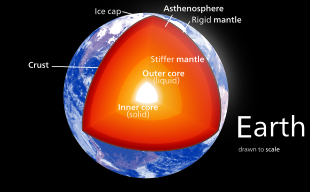Lower mantle

The lower mantle, historically also known as the mesosphere, represents approximately 56% of Earth's total volume, and is the region from 660 to 2900 km below Earth's surface; between the transition zone and the outer core.[1] The preliminary reference Earth model (PREM) separates the lower mantle into three sections, the uppermost (660–770 km), mid-lower mantle (770–2700 km), and the D layer (2700–2900 km).[2] Pressure and temperature in the lower mantle range from 24–127 GPa[2] and 1900–2600 K.[3] It has been proposed that the composition of the lower mantle is pyrolitic,[4] containing three major phases of bridgmanite, ferropericlase, and calcium-silicate perovskite. The high pressure in the lower mantle has been shown to induce a spin transition of iron-bearing bridgmanite and ferropericlase,[5] which may affect both mantle plume dynamics[6][7] and lower mantle chemistry.[5]
The upper boundary is defined by the sharp increase in
Physical properties
The lower mantle was initially labelled as the D-layer in Bullen's spherically symmetric model of the Earth.[9] The PREM seismic model of the Earth's interior separated the D-layer into three distinctive layers defined by the discontinuity in seismic wave velocities:[2]
- 660–770 km: A discontinuity in compression wave velocity (6–11%) followed by a steep gradient is indicative of the transformation of the mineral ringwoodite to bridgmanite and ferropericlase and the transition between the transition zone layer to the lower mantle.
- 770–2700 km: A gradual increase in velocity indicative of the adiabaticcompression of the mineral phases in the lower mantle.
- 2700–2900 km: The outer core.
The temperature of the lower mantle ranges from 1,960 K (1,690 °C; 3,070 °F) at the topmost layer to 2,630 K (2,360 °C; 4,270 °F) at a depth of 2,700 kilometres (1,700 mi).[3] Models of the temperature of the lower mantle approximate convection as the primary heat transport contribution, while conduction and radiative heat transfer are considered negligible. As a result, the lower mantle's temperature gradient as a function of depth is approximately adiabatic.[1] Calculation of the geothermal gradient observed a decrease from 0.47 kelvins per kilometre (0.47 °C/km; 1.4 °F/mi) at the uppermost lower mantle to 0.24 kelvins per kilometre (0.24 °C/km; 0.70 °F/mi) at 2,600 kilometres (1,600 mi).[3]
Composition
The lower mantle is mainly composed of three components, bridgmanite, ferropericlase, and calcium-silicate perovskite (CaSiO3-perovskite). The proportion of each component has been a subject of discussion historically where the bulk composition is suggested to be,
- Pyrolitic: derived from petrological composition trends from upper mantle peridotite suggesting homogeneity between the upper and lower mantle with a Mg/Si ratio of 1.27. This model implies that the lower mantle is composed of 75% bridgmanite, 17% ferropericlase, and 8% CaSiO3-perovskite by volume.[4]
- Chondritic: suggests that the Earth's lower mantle was accreted from the composition of chondritic meteorite suggesting a Mg/Si ratio of approximately 1. This infers that bridgmanite and CaSiO3-perovskites are major components.
Laboratory multi-anvil compression experiments of pyrolite simulated conditions of the adiabatic geotherm and measured the density using in situ X-ray diffraction. It was shown that the density profile along the geotherm is in agreement with the PREM model.[10] The first principle calculation of the density and velocity profile across the lower mantle geotherm of varying bridgmanite and ferropericlase proportion observed a match to the PREM model at an 8:2 proportion. This proportion is consistent with the pyrolitic bulk composition at the lower mantle.[11] Furthermore, shear wave velocity calculations of pyrolitic lower mantle compositions considering minor elements resulted in a match with the PREM shear velocity profile within 1%.[12] On the other hand, Brillouin spectroscopic studies at relevant pressures and temperatures revealed that a lower mantle composed of greater than 93% bridgmanite phase has corresponding shear-wave velocities to measured seismic velocities. The suggested composition is consistent with a chondritic lower mantle.[13] Thus, the bulk composition of the lower mantle is currently a subject of discussion.
Spin transition zone
The electronic environment of two iron-bearing minerals in the lower mantle (bridgmanite, ferropericlase) transitions from a high-spin (HS) to a low-spin (LS) state.[5] Fe2+ in ferropericlase undergoes the transition between 50–90 GPa. Bridgmanite contains both Fe3+ and Fe2+ in the structure, the Fe2+ occupy the A-site and transition to a LS state at 120 GPa. While Fe3+ occupies both A- and B-sites, the B-site Fe3+ undergoes HS to LS transition at 30–70 GPa while the A-site Fe3+ exchanges with the B-site Al3+ cation and becomes LS.[14] This spin transition of the iron cation results in the increase in partition coefficient between ferropericlase and bridgmanite to 10–14 depleting bridgmanite and enriching ferropericlase of Fe2+.[5] The HS to LS transition are reported to affect the physical properties of the iron bearing minerals. For example, the density and incompressibility was reported to increase from HS to LS state in ferropericlase.[15] The effects of the spin transition on the transport properties and rheology of the lower mantle is currently being investigated and discussed using numerical simulations.
History
Mesosphere (not to be confused with
A derivative term, mesoplates, was introduced as a heuristic, based on a combination of "mesosphere" and "plate", for postulated reference frames in which mantle hotspots exist.[17]
See also
References
- ^ OCLC 988167555.
- ^ ISSN 0031-9201.
- ^ ISSN 0031-9201.
- ^ OCLC 16375050.
- ^ S2CID 12208090.
- ISSN 0956-540X.
- ISSN 0094-8276.
- ^ ISBN 0-521-01472-7.
- .
- S2CID 19243930.
- ISSN 1752-0894.
- .
- S2CID 4387193.
- ISSN 0084-6597.
- S2CID 21661449.
- ^ Daly, Reginald Aldworth (1940). Strength and Structure of the Earth. New York: Prentice Hall.
- ISBN 978-0-12-468750-9.
